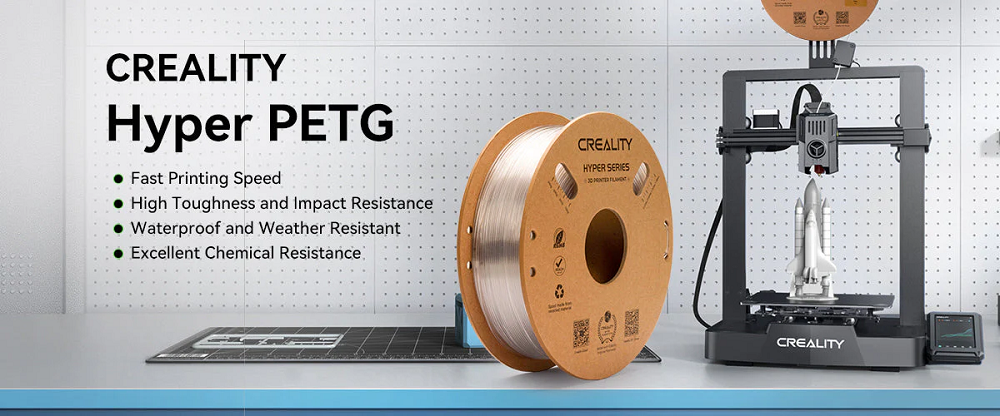Need to print stunning, translucent 3D objects? Clear 3D printing filament is what you've been scouting for. But with so many options out there, how do you choose the best transparent 3D filament or decide between different materials? If you've ever ended up with cloudy or frosted results using PLA or PETG, you’re definitely at the right place.
In this guide, we’ll explain what the clear filament really means, which materials give you the best results, and share expert tips to help your prints come out as crisp and clear as possible.
What Is Clear 3D Printer Filament?
Clear or transparent filament is a type of thermoplastic designed to be transparent. The light goes through the material, resulting in prints that range from translucent to almost entirely transparent. FDM printers cannot yet produce the full transparency of glass, but with certain materials like transparent PLA or clear PETG, it is possible to produce extremely great results—given the right settings and finishing.

The filament works best when you desire semi-transparency or a clean, presentable appearance, which is commonly observed in lighting displays, product models, or embellishments.
Is PETG or PLA Better for Transparency?
The most common types you'll encounter are clear PLA and PETG filaments, so which one enjoys better transparency?
|
Feature
|
Clear PLA Filament
|
Clear PETG Filament
|
|
Ease of Use
|
Very beginner-friendly
|
Fine-tuning required (retraction/temp)
|
|
Transparency
|
Good, but may look slightly milky or yellowish
|
Excellent — more glass-like results
|
|
Durability
|
Less durable, lower heat resistance
|
Stronger, impact-resistant, higher heat tolerance
|
|
Best For
|
Prototypes, decorations, simple display items
|
Functional parts, high-clarity projects
|
|
Print Settings
|
Simple; minimal adjustments needed
|
Needs careful tweaking for optimal clarity
|
|
Final Verdict
|
Easy and “good enough” clarity
|
Best choice for crystal-clear, tough prints
|
When to Use Clear Filament for 3D Printer
Transparent filament is not all about looks — it's actually very useful for all sorts of projects. Whether you want a clear, glass-like look or have functional requirements for transparency, here are some great applications:
Prototyping & functionality Transparent filament makes it easy to "see inside" your models when testing them out in the real world. It's therefore easy to see fluid flow or even internal components of a design.
Art & jewelry design Clear filaments are perfect for creative projects that play with light and shadow — from abstract sculptures to eye-catching, modern jewelry.
Medical & anatomical models Doctors, students, or teachers often employ clear prints to demonstrate internal body organs with excellent visibility.
Decorative home items Print gorgeous vases, lampshades, and ornaments that let light shine through for an elegant, ambient effect.
Housings & enclosures Need an electronics enclosure where inner components must be visible? Clear filament offers both protection and visibility.
Educational models Ideal for demonstrating light refraction, optical paths, or mechanical systems in classrooms and science fairs.
Best Transparent 3D Filament in 2025
If you’re chasing that truly clear, glass-like look, PETG is the way to go. PLA’s easier to work with, but it usually turns out cloudy—not ideal for transparency. That’s why I’m more focusing on these PETG picks that actually deliver.
Creality Transparent PETG Filament
Looking for a transparent filament with the optimal clarity/durability blend? Creality's Hyper Series PETG Filament is a winner with excellent transparency and high-speed printability, and it's perfect for beginners and master makers alike.

Features:
-
High transparency with a glossy finish, ideal for light diffusers and decorative items.
-
Supports high-speed printing up to 300mm/s, reducing print time without compromising quality.
-
Excellent layer adhesion and very minimal warping.
-
Water-resistant and UV-stable, suitable for outdoor applications.
Prices:
$18.99/1KG
Verdict:
While not as crystal-clear as some premium filaments, Creality's Hyper PETG offers a solid balance of transparency, durability, and ease of use. It's a reliable choice for functional parts and decorative prints.
How to Get the Clearest Results with 3D Printer
Even after buying clear 3D print filament, there are some practical tricks that will push your FDM prints to crystal clear:
-
Print incredibly slowly
-
Target 10–20 mm/s to allow filament lines to melt and join with each other.
-
Use high temperatures and turn off cooling
-
Increase nozzle temperatures (such as ~240 °C for PETG), and disable or diminish fan cooling to permit improved layer adhesion.
-
Max out infill or use solid walls
-
Print with 100% infill or thick single-wall/vase-mode to prevent gaps that diffuse light.
-
Align infill and extrusion paths consistently
-
Use "aligned rectilinear" or fixed-direction infill so lines move progressively from one layer to the next.
-
Go big with nozzle/line widths and layer heights
-
A 0.6–0.8 mm nozzle with thick layers helps create smoother internal fill.
-
Dry your filament thoroughly
-
Even slight moisture from a wet spool can fog the finish—store and dry your filaments thoroughly before printing.
If you want that extra gloss:
- Sand paper to smooth 3D prints: Wet-sand to 3000 grit, followed by clear coat, evens out noticeable layer lines.
- Resin or varnish coat: Brushing on clear resin or acrylic polish will fill surface openings and add glass-like gloss.
Conclusion
Clear 3D printing filament can unlock stunning visual effects—if you choose the right material and settings. While PLA offers ease of use, PETG is the go-to for higher clarity and strength. By picking a quality transparent PETG and dialing in your print settings, you can achieve impressively clear results for everything from display pieces to functional prototypes.
